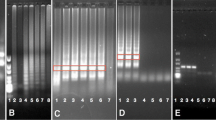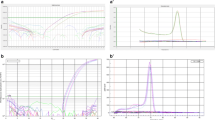Abstract
The objective of the present study was to assess the applicability of the MON 810 5′ event-specific method validated by the Community Reference Laboratory for Genetically Modified Food and Feed that is commonly used for quantitative purposes. This 5′ event-specific/hmg-taxon gene real-time polymerase chain reaction (PCR) protocol coupled to \(2^{ - \Delta \Delta CT} \) analysis was the chosen approach to determine the MON 810 insert copy number per haploid genome across 26 genetically modified commercial maize varieties. Variety DK 513 containing one copy integration per haploid genome was used as calibrator in each assay. Complementary data from end-point real-time PCRs that targeted specifically the MON 810 insert were also analyzed. Global results assessed and guaranteed the genetic intactness of the transgenic integration per haploid genome for 24 out of the 26 commercial varieties studied, which showed no significant differences between \(2^{ - \Delta \Delta CT} \) values respect to the calibrator value. Conversely, two varieties showed no intact transgenic insert in their genomes. This validated analytical method was suitable for MON 810 detection and quantification purposes.
Similar content being viewed by others
References
Aguilera M, Querci M, Balla B, Prospero A, Ermolli M, Van den Eede G (2008) A qualitative approach for the assessment of the genetic stability of the MON 810 trait in commercial seed maize varieties. Food Anal Met. doi: 10.1007/s12161-008-9035-2
Arumuganathan K, Earle ED (2001) Chromosome 2-specific DNA clones from flow-sorted chromosomes of tomato. Plant Mol Biol Rep 9:211
Bellocchi G, Acutis M, Paoletti C, Confalonieri R, Trevisiol P, Grazioli E, Delobel C, Savini C, Mazzara M, Van den Eede G (2008) Expanding Horizons in the Validation of GMO Analytical Methods: Fuzzy-based Expert Systems. Food Anal Met. 1(2):126 doi: 10.1007/s12161-008-9021-8
Bubner B, Gase K, Baldwin IT (2004) Two-fold differences are the detection limit for determining transgene copy numbers in plants by real-time PCR. BMC Biotechnol 4:14
Buh Gasparic M, Cankar K, Zel J, Gruden K (2008) Comparison of different real-time PCR chemistries and their suitability for detection and quantification of genetically modified organisms. BMC Biotechnol 8(1):26
Chaouachi M, Giancola S, Romaniuk M, Laval V, Bertheau Y, Brunel D (2007) A strategy for designing multi-taxa specific reference gene systems. Example of application--ppi phosphofructokinase (ppi-PPF) used for the detection and quantification of three taxa: maize (Zea mays), cotton (Gossypium hirsutum) and rice (Oryza sativa). J Agric Food Chem 55(20):8003
Charels D, Broeders S, Corbisier P, Trapmann S, Schimmel H, Linsinger T, Emons H, Agric J (2007a) Toward metrological traceability for DNA fragment ratios in GM quantification. 2. Systematic study of parameters influencing the quantitative determination of MON 810 corn by real-time PCR. Food Chem 55(9):3258
Charels D, Broeders S, Corbisier P, Trapmann S, Schimmel H, Emons H (2007b) Toward metrological traceability for DNA fragment ratios in GM quantification. 3. Suitability of DNA calibrants studied with a MON 810 corn model. J Agric Food Chem 55(9):3268
Corbisier P, Broothaerts W, Gioria S, Schimmel H, Burns M, Baoutina A, Emslie KR, Furui S, Kurosawa Y, Holden MJ, Kim HH, Lee YM, Kawaharasaki M, Sin D, Wang J, Agric J (2007) Toward metrological traceability for DNA fragment ratios in GM quantification. 1. Effect of DNA extraction methods on the quantitative determination of Bt176 corn by real-time PCR. Food Chem 55(9):3249
Dalla Costa L, Martinelli LM (2007) Development of a real-time PCR method based on duplo target plasmids for determining an unexpected genetically modified soybean intermix with feed components. J Agric Food Chem 55(4):1264
De Preter K, Speleman F, Combaret V, Lunec J, Laureys G, Eussen BH, Francotte N, Board J, Pearson AD, De Paepe A, Van Roy N, Vandesompele J (2002) Quantification of MYCN, DDX1, and NAG gene copy number in neuroblastoma using a real-time quantitative PCR assay. Mod Pathol 15(2):159
Fu X, Duc LT, Fontana S, Bong BB, Tinjuangjun P, Sudhakar D, Twyman RM, Christou P, Kohli A (2000) Linear transgene constructs lacking vector backbone sequences generate low-copy-number transgenic plants with simple integration patterns. Transgenic Res 9(1):11
Mason G, Provero P, Vaira AM, Accotto GP (2002) Estimating the number of integrations in transformed plants by quantitative real-time PCR. BMC. Biotechnol 2:20
Hernández M, Rodríguez-Lázaro D, Ferrando A (2005) Current Methodology for Detection, Identification and Quantification of Genetically Modified Organisms. Current Anal Chem 1:203
Hernández M, Pla M, Esteve T, Prat S, Puigdomenech P, Ferrando A (2003) A specific real-time quantitative PCR detection system for event MON 810 in maize YieldGard based on the 3'-transgene integration sequence. Transgenic Res 12(2):179
Hernández M, Duplan M, Berthier G, Vaïtilingom M, Hauser W, Freyer R, Pla M, Bertheau Y (2004) Development and comparison of four real-time polymerase chain reaction systems for specific detection and quantification of Zea mays L. J Agric Food Chem 52(15):4632
Holck A, Va M, Didierjean L, Rudi K (2002) 5'-Nuclease PCR for quantitative event-specific detection of the genetically modified MON 810 MaisGard maize. Eur Food Res Techn 214:449
ISO 21570:2005, Foodstuffs—methods of analysis for the detection of genetically modified organisms and derived products—quantitative nucleic acid based methods, © ISO 2005
ISO 24276:2006, Foodstuffs—methods of analysis for the detection of genetically modified organisms and derived products—general requirements and definitions, © ISO 2006
Ingham DJ, Beer S, Money S, Hansen G (2001) Quantitative real-time PCR assay for determining transgene copy number in transformed plants. Biotechniques 31(1):132
La Paz JL, Esteve T, Pla M (2007) Comparison of real-time PCR detection chemistries and cycling modes using MON 810 event-specific assays as model. J Agric Food Chem 55(11):4312
Livak KJ, Schmittgen TD (2001) Analysis of relative gene expression data using real-time quantitative PCR and the 2(-Delta Delta C(T)). Methods 25(4):402
Papazova N, Windels P, Depicker A, Taverniers I, Roldan-Ruiz I, Milcamps A, Van Bockstaele E, Van den Eede G, De Loose M (2006) Sequence stability of the T-DNA-plant junctions in tissue culture in Arabidopsis transgenic lines. Plant Cell Rep 25(12):1362
Prior FA, Tackaberry ES, Aubin RA, Casley WL (2006) Accurate determination of zygosity in transgenic rice by real-time PCR does not require standard curves or efficiency correction. Transgenic Res 15(2):261
Regulation (EC) No 1829/2003 of the European Parliament and of the Council of 22 September 2003 on genetically modified food and feed. Off. J. Eur. Union 268:1 (2003a)
Regulation (EC) No 1830/2003 of the European Parliament and of the Council of 22 September 2003 concerning the traceability and labelling of genetically modified organisms and the traceability of food and feed products produced from genetically modified organisms and amending Directive 2001/18/EC. Off. J. Eur. Union 268, 24 (2003b)
Trapmann S, Guern LL, Prokisch J, Robouch P, Kramer GN, Schimmel H, Pauwels J, Querci M, Van den Eede G, Anklam E (2001) The certification of Reference Materials of Dry Mixed Maize powder with different Mass fractions of MON 810 Maize. BCR Informations Series
Yang L, Guo J, Pan A, Zhang H, Zhang K, Wang Z, Zhang D (2007) Event-specific quantitative detection of nine genetically modified maizes using one novel standard reference molecule. Agric JFood Chem 55(1):15
Žel J, Mazzara M, Savini C, Cordeil S, Camloh M, Štebih D, Cankar K, Gruden K, Morisset D, Van den Eede G (2008) Method Validation and Quality Management in the Flexible Scope of Accreditation: An Example of Laboratories Testing for Genetically Modified Organisms. Food Anal Met. 1(2):61 doi: 10.1007/s12161-008-9016-5
Acknowledgments
The commercial seeds were kindly provided by INIA, Seville (Spanish Ministry of Science). The authors wish to thank Fabrizia Scabini for technical support.
Author information
Authors and Affiliations
Corresponding author
Rights and permissions
About this article
Cite this article
Aguilera, M., Querci, M., Pastor, S. et al. Assessing Copy Number of MON 810 Integrations in Commercial Seed Maize Varieties by 5′ Event-Specific Real-Time PCR Validated Method Coupled to \(2^{ - \Delta \Delta CT} \) Analysis. Food Anal. Methods 2, 73–79 (2009). https://doi.org/10.1007/s12161-008-9036-1
Received:
Accepted:
Published:
Issue Date:
DOI: https://doi.org/10.1007/s12161-008-9036-1




